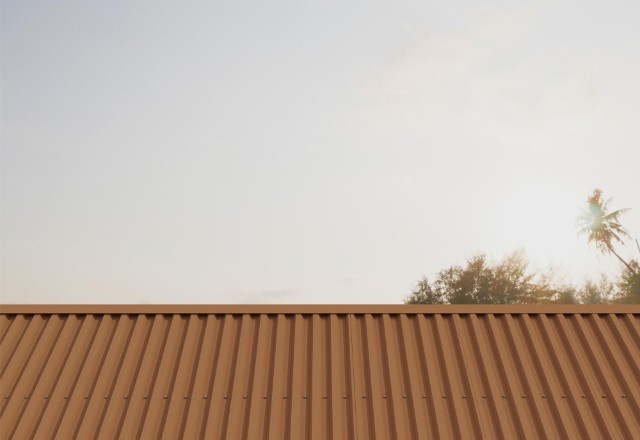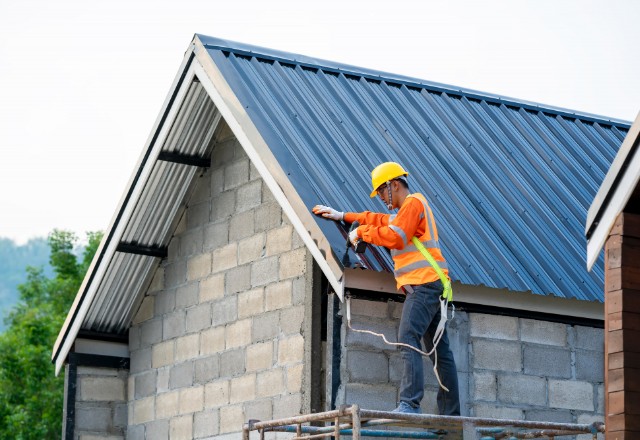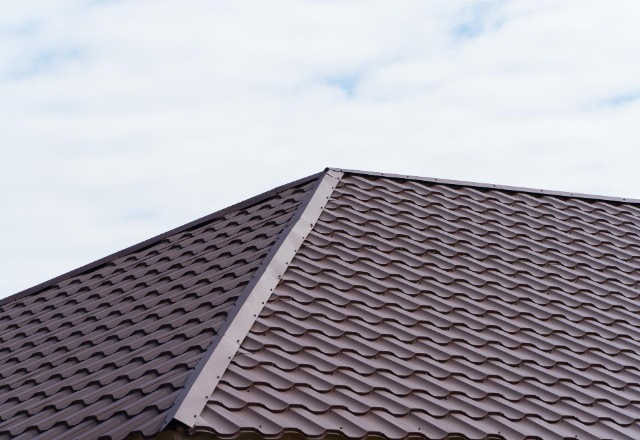Corrugated metal roofing is quickly becoming one of the most popular and cost-effective types of roofing materials on the market today. With its durable and stylish design, it’s no wonder why so many homeowners are choosing to install corrugated metal roofs. But while the installation process seems straightforward, there are a few tips and tricks that can help you achieve a professional-looking finish. In this guide, we’ll give you all the information you need to know to install your corrugated metal roof with ease—from preparation and planning through to finishing touches. So if you’re looking for an easy way to spruce up your home, read on to learn how to get that perfect professional look!
Disclaimer: This article provides helpful tips and tricks for installing corrugated metal roofing. However, the installation of such materials should always be done by a professional contractor. We recommend consulting with Advance Roofing LLC for any questions you may have before embarking on your project. With years of experience in the Spokane, WA area, Advance Roofing LLC is dedicated to providing customers with superior quality roofing solutions.
What Is Corrugated Metal Roofing?
Corrugated metal roofing is an attractive and cost-effective option for residential and commercial buildings. It’s made up of two pieces of metal that are pressed together to form wavy ridges and valleys, known as “corrugations”. These corrugations provide extra strength to the roof, as well as helping it better withstand extreme weather conditions. Corrugated metal roofing also offers excellent insulation, meaning you can save money on energy bills while still keeping your home comfortable. It’s also lightweight, making it easy to install without needing additional support structures. With its unique design and durability, corrugated metal roofing is an increasingly popular choice for homeowners looking for a stylish and reliable roofing material.
Corrugated metal roofing is a great option for those looking for an attractive and reliable roofing material that will last for years to come. With its unique design, durability, and energy-saving insulation benefits, it’s easy to see why this type of roofing is becoming more popular with homeowners all the time. And that’s not all – stay tuned to learn about all the other benefits of installing corrugated metal roofing!

Benefits of Installing Corrugated Metal Roofing
Installing corrugated metal roofing is a great option for homeowners looking for an attractive and reliable roofing material that will last for years to come. The unique design of corrugated metal roofing helps it withstand extreme weather conditions, while providing excellent insulation that can help you save money on energy bills. It’s also lightweight, making it easy to install without the need for additional support structures.
Corrugated metal roofing also comes in a variety of colors, allowing you to customize the look of your home, and keep it looking good all year round. With its durability, low maintenance needs, and attractive appearance, corrugated metal roofing is an ideal choice for those looking to create a beautiful and functional space.
Preparation and Planning
When it comes to installing corrugated metal roofing, preparation and planning are key.
Before you begin, make sure that the area is clean and free of debris or other items that might interfere with the installation process.
Measure the area where the roof will be installed to ensure that you have enough material to complete the job.
You’ll also want to check for any structural integrity issues, such as weakened supports or rotted wood framing.
Finally, take into account your local weather conditions when selecting a type of metal roofing material – some materials may not be suitable for certain climates.
With proper preparation and planning in place, you can ensure a professional-looking installation job that will last for years to come.
A quality corrugated metal roof is an investment that can provide lasting protection for your home or business. With the proper preparation and planning, you can enjoy a professional-looking installation job that will last for years to come. Now it’s time to start thinking about getting the right materials for the job – let’s take a look at what it takes to make sure you have the perfect fit!
Getting the Right Materials
Once you’ve completed the necessary preparation and planning steps, it’s time to start thinking about getting the right materials for your corrugated metal roofing installation. The type of material you choose will depend largely on factors such as local climate and weather conditions, as well as the size of your roof. You’ll also need to consider factors such as color and texture when selecting a material that best suits your needs. Generally speaking, most metal roofing materials come in 26-gauge sheets and can be either galvanized or painted for extra protection against rust and other elements. When shopping for metal roofing panels, make sure to purchase enough for all areas of your roof – you don’t want to run out halfway through the job! With the right materials in hand, you’ll be well on your way to a successful corrugated metal roof installation.
Pre-Installation Considerations
Once you’ve chosen the right materials for your corrugated metal roof installation, it’s important to take a few moments to consider the steps and techniques that will ensure the best results.
Start by checking your local building regulations to make sure that you are adhering to all relevant codes and requirements.
It’s also essential to check for any possible obstructions in the way of your planned installation, such as trees or power lines.
If necessary, enlist professional help from an experienced contractor to evaluate any potential issues before starting work on your roof.
Finally, carefully measure out and plan for a designated area for waste disposal, as this will make cleanup much easier once the job is done.
Taking these pre-installation considerations into account will ensure a safe and successful installation process.

Selecting a Roofer
Selecting a roofer is an important decision that requires you to do your research and choose the right professional for the job.
Start by reaching out to friends, family and local contractors who can provide you with recommendations.
When you have a list of potential candidates, make sure that each one has experience with the type of roofing material you are planning to use.
It’s also important to check their licensing and insurance information, as well as any reviews or ratings online.
Once you’ve gathered enough information about each option, take some time to compare prices in order to get the best deal for your budget.
Finally, don’t be afraid to ask questions during the process – this will help ensure that your chosen contractor understands all of your needs and expectations before beginning work on your new roof.
Installation Process
Installing corrugated metal roofing is a great way to protect your home and provide it with a professional look.
Start by measuring the length and width of the area you’d like to cover, then purchase enough panels to accommodate those dimensions.
Before installing the panels, make sure that they are securely fastened to the structure and check for any signs of damage or corrosion.
Once all the panels are in place, use screws and nails to secure them into place.
Finally, add any necessary sealants or flashing around the edges to ensure that everything is properly sealed and waterproofed.
With some patience and attention to detail you can easily achieve a beautiful finish that will last for years.
With the right tools and a little bit of know-how, installing corrugated metal roofing is an easy and rewarding process. Now that you’ve got the basics down, it’s time to focus on one of the most important aspects: Layout of the Roof.
Layout of the Roof
Layout of the Roof is an important part of installing corrugated metal roofing. First, decide on the direction you’d like your panels to run and mark that on the roof’s surface. Then measure each section and cut the panels to size with a circular saw or electric shears. Once all the panels are cut, lay them out on the roof in their designated pattern before nailing them into place. If you’re using sealant or flashing around the edges, now is also a great time to apply it and ensure that everything is properly sealed. With some patience and attention to detail you can easily achieve a professional look that will last for years.
Setting Up the System: Underlayment, Flashing, and Fasteners Setting up the system is an important step in installing corrugated metal roofing.
Start by laying down a layer of underlayment material such as felt paper or synthetic underlayment. This will help protect your home from water intrusion and provide a base for the metal panels to rest on.
Next, install flashing around the edges of your roof where it meets other materials like walls, chimneys, or vents.
Finally, secure the panels to the roof with your choice of fasteners such as nails or screws.
Make sure they are installed at the right depth and spacing according to manufacturer instructions for optimal performance and a professional look. With proper setup, you can ensure that your metal roofing installation lasts for many years to come!

Installing Panels and Seams
Once the system is set up, it’s time to install the metal panels.
Begin by attaching the first panel at one corner of your roof and work outward towards the other end.
Make sure each panel has enough overlap with adjacent panels to ensure a watertight seal.
When you reach the edges of your roof, use special trim pieces called endwalls to create a neat and finished look.
At seams and joints, use sealant or flashing tape to further waterproof and protect your roof from leakage.
Finally, inspect all of your panels for any signs of damage or imperfections before securing them in place.
With proper installation techniques, you can ensure that your corrugated metal roof provides long-lasting protection for years to come!
Finishing Up: Trim, Vents and Accessories
Once you’ve secured all of your panels in place, it’s time to finish up the installation.
Begin by adding any trim pieces or accessories that you desire, such as edging, gable trims and ridge caps. This will give your roof a neat and finished look. If you’re installing a standing seam metal roof, make sure to use clips to secure the vertical seams in place.
Next, add vents such as exhaust fans or turbines to ensure optimal air flow throughout your attic space.
Finally Fina , inspect all of your work for any defects or problems before giving yourself a well-deserved pat on the back!
With these simple steps, you can create a beautiful corrugated metal roof that will provide long-lasting protection for years to come!
Tips for Professional Results
Installing a corrugated metal roof can add long-lasting protection and beauty to your home. To get the best results, make sure to take your time and follow these tips for a professional look.
Firstly, measure your roof accurately and cut the panels to fit snugly – it’s very important that they’re properly secured.
Secondly, use corrosion-resistant nails or screws when attaching the panels to ensure longevity.
Thirdly, caulk any seams or joints with an appropriate sealant for extra protection against water infiltration.
Finally, finish up by adding trim pieces and accessories such as gable trims and ridge caps for a neat look. With these simple steps you can create a stunning metal roof that will keep your home safe from the elements!
With a corrugated metal roof, you can create a beautiful and durable home improvement that will last for years to come. Now that you know how to install it, the next step is choosing the right color to make your roof shine!

Choosing the Right Color
Choosing the right color for your corrugated metal roof can be a daunting task. Fortunately, there are a few tips to help you make an informed decision.
Firstly, consider the style and architecture of your home – certain colors will look better with certain designs.
Secondly, think about how the color will look in different lighting or from different angles – you want it to be aesthetically pleasing no matter what.
Finally, take into account any local building codes that may dictate which colors are allowed in your area.
With these tips in mind, you’ll have no trouble finding the perfect fit to make your roof shine!
Using the Correct Tools and Techniques
The use of appropriate tools and techniques is crucial for achieving a polished result during the installation of corrugated metal roofing.
Start by measuring the area you need to cover and then buy enough material to cover it.
You’ll also need a few tools, such as a saw, drill, hammer, level, tape measure, safety goggles and gloves.
Before you begin installation, make sure your work surface is clean and level.
Use caution when handling the panels so that they don’t get damaged or bent out of shape.
When cutting the panels, use straight cuts to ensure proper fitment.
Finally, be sure to secure each panel with the recommended fasteners in order to ensure a safe and secure installation.
With these tips in mind, your corrugated metal roof will look great!
Pay Attention to Details and Double-Check Your Work
Attention to detail and thoroughness are important when installing corrugated metal roofing. Take the time to measure twice and cut once. Make sure that all of your panels fit perfectly before you secure them. If a panel needs to be trimmed or adjusted, take the time to do it properly rather than rushing through the job. Also, make sure that your fasteners are tight enough so that wind and rain won’t cause any damage. Finally Fina , check for gaps between panels or around edges where water could enter. Taking these extra steps will ensure a professional looking roof that will last for years to come!
Maintenance and Care of Corrugated Metal Roofs
It’s important to take proper care of your corrugated metal roof. Regular maintenance will help ensure the longevity of your roof and prevent any unexpected issues.
To start, make sure to inspect the entire surface for any signs of damage or wear and tear. Check for any rust, gaps between panels, or loose fasteners that could allow water leaks.
Additionally, it’s important to keep your roof clean by removing any leaves, dirt, or debris that has accumulated on top of it over time.
Finally, check the edges of the panels and around vents or other openings to make sure they are sealed properly to keep out water and pests.
Following these simple steps will help you maintain your corrugated metal roof in top condition!
By following these tips, you can ensure that your corrugated metal roof will last for years to come and give you peace of mind. Now that you know how to properly care for your corrugated metal roof, get ready for the next step: regular maintenance checks.
Regular Maintenance Checks
Performing routine maintenance checks is crucial to maintain the longevity and durability of your corrugated metal roof. These checks should be done at least twice a year, or after any major storms that have occurred in the area. During these checks, you should inspect the entire roof surface for any signs of damage or wear and tear. Additionally, check
around vents and other openings to make sure they are sealed properly. Furthermore, look for any rusting or gaps between panels that could lead to water leakage. By taking these simple steps during regular maintenance checks, you can prevent costly problems from occurring down the road.
Cleaning and Repairs
Cleaning and repairs are important for maintaining a corrugated metal roof in good condition. Regular cleaning can help remove dirt, debris, and other materials that may be causing damage to the roof over time. Cleaning should be done at least twice a year, or after any major storms that have occurred in the area. Additionally, it’s important to look for any signs of wear and tear and make necessary repairs as soon as you spot them. This could include replacing damaged panels or shingles, sealing gaps between panels, or painting over rust spots. By taking these steps during your regular maintenance checks, you will ensure your roof remains in top condition for years to come.
Conclusion
Installing a corrugated metal roof is a great way to add style and durability to your home. With the right preparation, the appropriate materials, and the step-by-step instructions provided here, you can have your new roof installed in no time at all. By following these tips and tricks, you’ll be able to enjoy a professional looking finish that will last for years with minimal maintenance. With this knowledge in hand, you’ll be ready to start your own corrugated metal roofing project!



 509-201-4190
509-201-4190
